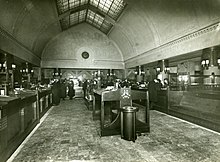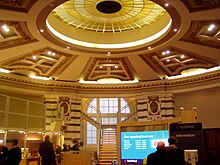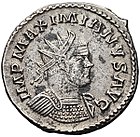A | B | C | D | E | F | G | H | CH | I | J | K | L | M | N | O | P | Q | R | S | T | U | V | W | X | Y | Z | 0 | 1 | 2 | 3 | 4 | 5 | 6 | 7 | 8 | 9
This article needs additional citations for verification. (May 2016) |
| Part of a series on financial services |
| Banking |
|---|
 |
A bank is a financial institution that accepts deposits from the public and creates a demand deposit while simultaneously making loans.[1] Lending activities can be directly performed by the bank or indirectly through capital markets.[2]
Whereas banks play an important role in financial stability and the economy of a country, most jurisdictions exercise a high degree of regulation over banks. Most countries have institutionalized a system known as fractional-reserve banking, under which banks hold liquid assets equal to only a portion of their current liabilities.[3] In addition to other regulations intended to ensure liquidity, banks are generally subject to minimum capital requirements based on an international set of capital standards, the Basel Accords.[4]
Banking in its modern sense evolved in the fourteenth century in the prosperous cities of Renaissance Italy but, in many ways, functioned as a continuation of ideas and concepts of credit and lending that had their roots in the ancient world. In the history of banking, a number of banking dynasties – notably, the Medicis, the Pazzi, the Fuggers, the Welsers, the Berenbergs, and the Rothschilds – have played a central role over many centuries. The oldest existing retail bank is Banca Monte dei Paschi di Siena (founded in 1472), while the oldest existing merchant bank is Berenberg Bank (founded in 1590).
History
This section needs expansion with: history after the 19th century. You can help by adding to it. (August 2020) |

Banking as an archaic activity (or quasi-banking[5][6]) is thought to have begun as early as the end of the 4th millennium BCE,[7] to the 3rd millennia BCE.[8][9]
Medieval
The present era of banking can be traced to medieval and early Renaissance Italy, to the rich cities in the centre and north like Florence, Lucca, Siena, Venice and Genoa. The Bardi and Peruzzi families dominated banking in 14th-century Florence, establishing branches in many other parts of Europe.[10] Giovanni di Bicci de' Medici set up one of the most famous Italian banks, the Medici Bank, in 1397.[11] The Republic of Genoa founded the earliest-known state deposit bank, and Banco di San Giorgio (Bank of St. George), in 1407 at Genoa, Italy.[12]
Early modern

Fractional reserve banking and the issue of banknotes emerged in the 17th and 18th centuries. Merchants started to store their gold with the goldsmiths of London, who possessed private vaults, and who charged a fee for that service. In exchange for each deposit of precious metal, the goldsmiths issued receipts certifying the quantity and purity of the metal they held as a bailee; these receipts could not be assigned, only the original depositor could collect the stored goods.
Gradually the goldsmiths began to lend money out on behalf of the depositor, and promissory notes, which evolved into banknotes, were issued for money deposited as a loan to the goldsmith. Thus, by the 19th century, we find in ordinary cases of deposits, of money with banking corporations, or bankers, the transaction amounts to a mere loan, or mutuum, and the bank is to restore, not the same money, but an equivalent sum, whenever it is demanded[13] and money, when paid into a bank, ceases altogether to be the money of the principal (see Parker v. Marchant, 1 Phillips 360); it is then the money of the banker, who is bound to return an equivalent, by paying a similar sum to that deposited with him, when he is asked for it. [14] The goldsmith paid interest on deposits. Since the promissory notes were payable on demand, and the advances (loans) to the goldsmith's customers were repayable over a longer time-period, this was an early form of fractional reserve banking. The promissory notes developed into an assignable instrument which could circulate as a safe and convenient form of money[15] backed by the goldsmith's promise to pay,[16][need quotation to verify] allowing goldsmiths to advance loans with little risk of default.[17][need quotation to verify] Thus the goldsmiths of London became the forerunners of banking by creating new money based on credit.

The Bank of England originated the permanent issue of banknotes in 1695.[18] The Royal Bank of Scotland established the first overdraft facility in 1728.[19] By the beginning of the 19th century Lubbock's Bank had established a bankers' clearing house in London to allow multiple banks to clear transactions. The Rothschilds pioneered international finance on a large scale,[20][21] financing the purchase of shares in the Suez canal for the British government in 1875.[22][need quotation to verify]
Etymology
The word bank was taken into Middle English from Middle French banque, from Old Italian banco, meaning "table", from Old High German banc, bank "bench, counter". Benches were used as makeshift desks or exchange counters during the Renaissance by Florentine bankers, who used to make their transactions atop desks covered by green tablecloths.[23][24]
Definition
The definition of a bank varies from country to country. See the relevant country pages for more information.
Under English common law, a banker is defined as a person who carries on the business of banking by conducting current accounts for their customers, paying cheques drawn on them and also collecting cheques for their customers.[25]


In most common law jurisdictions there is a Bills of Exchange Act that codifies the law in relation to negotiable instruments, including cheques, and this Act contains a statutory definition of the term banker: banker includes a body of persons, whether incorporated or not, who carry on the business of banking' (Section 2, Interpretation). Although this definition seems circular, it is actually functional, because it ensures that the legal basis for bank transactions such as cheques does not depend on how the bank is structured or regulated.
The business of banking is in many common law countries not defined by statute but by common law, the definition above. In other English common law jurisdictions there are statutory definitions of the business of banking or banking business. When looking at these definitions it is important to keep in mind that they are defining the business of banking for the purposes of the legislation, and not necessarily in general. In particular, most of the definitions are from legislation that has the purpose of regulating and supervising banks rather than regulating the actual business of banking. However, in many cases, the statutory definition closely mirrors the common law one. Examples of statutory definitions:
- "banking business" means the business of receiving money on current or deposit account, paying and collecting cheques drawn by or paid in by customers, the making of advances to customers, and includes such other business as the Authority may prescribe for the purposes of this Act; (Banking Act (Singapore), Section 2, Interpretation).
- "banking business" means the business of either or both of the following:
- receiving from the general public money on current, deposit, savings or other similar account repayable on demand or within less than ... or with a period of call or notice of less than that period;
- paying or collecting cheques drawn by or paid in by customers.[26]
Since the advent of EFTPOS (Electronic Funds Transfer at Point Of Sale), direct credit, direct debit and internet banking, the cheque has lost its primacy in most banking systems as a payment instrument. This has led legal theorists to suggest that the cheque based definition should be broadened to include financial institutions that conduct current accounts for customers and enable customers to pay and be paid by third parties, even if they do not pay and collect cheques .[27]
Standard business

Banks act as payment agents by conducting checking or current accounts for customers, paying cheques drawn by customers in the bank, and collecting cheques deposited to customers' current accounts. Banks also enable customer payments via other payment methods such as Automated Clearing House (ACH), Wire transfers or telegraphic transfer, EFTPOS, and automated teller machines (ATMs).
Banks borrow money by accepting funds deposited on current accounts, by accepting term deposits, and by issuing debt securities such as banknotes and bonds. Banks lend money by making advances to customers on current accounts, by making installment loans, and by investing in marketable debt securities and other forms of money lending.
Banks provide different payment services, and a bank account is considered indispensable by most businesses and individuals. Non-banks that provide payment services such as remittance companies are normally not considered as an adequate substitute for a bank account.
Banks issue new money when they make loans. In contemporary banking systems, regulators set a minimum level of reserve funds that banks must hold against the deposit liabilities created by the funding of these loans, in order to ensure that the banks can meet demands for payment of such deposits. These reserves can be acquired through the acceptance of new deposits, sale of other assets, or borrowing from other banks including the central bank.[28]
Range of activities
Activities undertaken by banks include personal banking, corporate banking, investment banking, private banking, transaction banking, insurance, consumer finance, trade finance and other related.
Channels

Banks offer many different channels to access their banking and other services:
- Branch, in-person banking in a retail location
- Automated teller machine banking adjacent to or remote from the bank
- Bank by mail: Most banks accept cheque deposits via mail and use mail to communicate to their customers
- Online banking over the Internet to perform multiple types of transactions
- Mobile banking is using one's mobile phone to conduct banking transactions
- Telephone banking allows customers to conduct transactions over the telephone with an automated attendant, or when requested, with a telephone operator
- Video banking performs banking transactions or professional banking consultations via a remote video and audio connection. Video banking can be performed via purpose built banking transaction machines (similar to an Automated teller machine) or via a video conference enabled bank branch clarification
- Relationship manager, mostly for private banking or business banking, who visits customers at their homes or businesses
- Direct Selling Agent, who works for the bank based on a contract, whose main job is to increase the customer base for the bank
Business models
A bank can generate revenue in a variety of different ways including interest, transaction fees and financial advice. Traditionally, the most significant method is via charging interest on the capital it lends out to customers.[29] The bank profits from the difference between the level of interest it pays for deposits and other sources of funds, and the level of interest it charges in its lending activities.
This difference is referred to as the spread between the cost of funds and the loan interest rate. Historically, profitability from lending activities has been cyclical and dependent on the needs and strengths of loan customers and the stage of the economic cycle. Fees and financial advice constitute a more stable revenue stream and banks have therefore placed more emphasis on these revenue lines to smooth their financial performance.
In the past 20 years, American banks have taken many measures to ensure that they remain profitable while responding to increasingly changing market conditions.
- First, this includes the Gramm–Leach–Bliley Act, which allows banks again to merge with investment and insurance houses. Merging banking, investment, and insurance functions allows traditional banks to respond to increasing consumer demands for "one-stop shopping" by enabling cross-selling of products (which, the banks hope, will also increase profitability).
- Second, they have expanded the use of risk-based pricing from business lending to consumer lending, which means charging higher interest rates to those customers that are considered to be a higher credit risk and thus increased chance of default on loans. This helps to offset the losses from bad loans, lowers the price of loans to those who have better credit histories, and offers credit products to high risk customers who would otherwise be denied credit.
- Third, they have sought to increase the methods of payment processing available to the general public and business clients. These products include debit cards, prepaid cards, smart cards, and credit cards. They make it easier for consumers to conveniently make transactions and smooth their consumption over time (in some countries with underdeveloped financial systems, it is still common to deal strictly in cash, including carrying suitcases filled with cash to purchase a home).
- However, with the convenience of easy credit, there is also an increased risk that consumers will mismanage their financial resources and accumulate excessive debt. Banks make money from card products through interest charges and fees charged to credit and debit card holders, and transaction fees to retailers[30] who accept the bank's cards for payments.
This helps in making a profit and facilitates economic development as a whole.[31]
Recently, as banks have been faced with pressure from fintechs, new and additional business models have been suggested such as freemium, monetisation of data, white-labeling of banking and payment applications, or the cross-selling of complementary products.[32]
Products


Retail
- ATM card
- Credit card
- Debit card
- Savings account
- Recurring deposit account
- Fixed deposit account
- Money market account
- Certificate of deposit (CD)
- Individual retirement account (IRA)
- Mortgage
- Mutual fund
- Personal loan (Secured and Unsecured Personal loan)
- Time deposits
- Current accounts
- Cheque books
- Automated teller machine (ATM)
- National Electronic Fund Transfer (NEFT)
- Real-time gross settlement (RTGS)
Business (or commercial/investment) banking
- Business loan
- Capital raising (equity / debt / hybrids)
- Revolving credit
- Risk management (foreign exchange (FX), interest rates, commodities, derivatives)
- Term loan
- Cash management services (lock box, remote deposit capture, merchant processing)
- Credit services
- Securities Services
Capital and risk
| Specific banking frameworks |
|---|
| Market risk |
| Credit risk |
|
| Counterparty credit risk |
| Operational risk |
>Text je dostupný pod licencí Creative Commons Uveďte autora – Zachovejte licenci, případně za dalších podmínek. Podrobnosti naleznete na stránce Podmínky užití.
Text je dostupný za podmienok Creative
Commons Attribution/Share-Alike License 3.0 Unported; prípadne za ďalších
podmienok.
Podrobnejšie informácie nájdete na stránke Podmienky
použitia.


